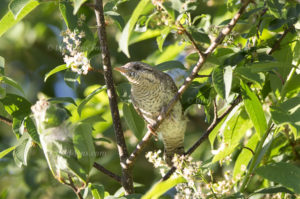 Hi-pitched callings are coming out of nowhere. Even the direction is not clear. In the poor light of the dawn I see a bird in flight. First I think of a Barred Warbler (Sylvia nisoria) or maybe a small female shrike like a Red-backed Shrike (Lanius collurio). Suddenly a Eurasian Wryneck (Jynx torquilla) hops around the woodland floor in search of a new anthill. It moves clumsily on flat ground, with its tail raised. With a few hammer blows from its bill, the wryneck breaks into the ants nest. Ants swarm out, but they do not have a chance. The Wryneck can hold 150 ants in its throat at any one time.
Hi-pitched callings are coming out of nowhere. Even the direction is not clear. In the poor light of the dawn I see a bird in flight. First I think of a Barred Warbler (Sylvia nisoria) or maybe a small female shrike like a Red-backed Shrike (Lanius collurio). Suddenly a Eurasian Wryneck (Jynx torquilla) hops around the woodland floor in search of a new anthill. It moves clumsily on flat ground, with its tail raised. With a few hammer blows from its bill, the wryneck breaks into the ants nest. Ants swarm out, but they do not have a chance. The Wryneck can hold 150 ants in its throat at any one time.
Afterwards the Wryneck flies to an oak tree, gripping the rough bark with its strong feet. It looks in holes in the bark for grubs and food items. The Eurasian Wryneck detects the tiny sound of a beetle moving behind the bark, and swiftly inserts its long tongue to catch the insect. The bird´s sharp, chisel-tipped bill enables it to smash into anthills. Specially adapted salivary glands keep its tongue sticky, so it can pick up ants with a flicking action. The tongue is also long enough to extract prey from under stones and within cracks in the bark.
The gourmet among the woodpeckers seeks his food – mostly insects – mainly on the ground. Especially during the breeding season, the Wryneck is tirelessly searching for ants, their larvae and pupae. If the ants have stored their larvae deep inside their buildings due to the wet cold weather, the wryneck must avoid aphids, small beetles, butterfly caterpillars and spiders. Occasionally he also eats soft fruits like elderberries.
As a breeding ground, the Wryneck chooses semi-forested or quite open landscapes that provide the bird with sufficient open space (grass and herb layers) for foraging on the ground. These are usually field trees, avenues, orchards and parks, but also light riparian forests, deciduous and mixed forests, and shores and wetlands with suitable trees.
A Wryneck is an unusual, distinctive woodpecker which shows a cryptic plumage. A complex pattern of spots, stripes and smudges breaks up the Wryneck´s outline. If threatened, it hunkers down and its plumage mimics the texture of tree bark and the effect of dappled light so perfectly that it effectively vanishes from sight. Mottled grey and brown above. The buffish-ochre breast is dark vermiculated, the whitish belly is dark vermiculated as well. A dark line is drawn through the eye and down neck-side. Obvious is the short pointed bill.
The Eurasian Wryneck was formerly a regular and fairly widespread breeder in Germany. Now it mainly – especially in the north-western part of the country – a scarce passage migrant mainly in May and in August-October. Similar declines have been seen elsewhere in Europe, particularly in northern France and in other North Sea countries.
To cope with the growing demand for top shots of the rarer species of the Palearctic Bird-Lens is keen to enrich the range of pictures of birds you can find in the western palearctic. Trips to remote places like this one to capture images of rare birds of western palearctic were very successful. The nice image of the blog is only a first impression, what you will find in the gallery in the “Picture Shop” very soon. Just give me a message, if I could serve you with an image needed before the new pictures are online.